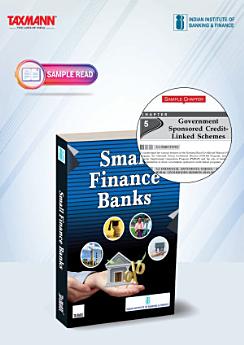IIBF X Taxmann's Small Finance Banks (SFB) – Comprehensive Guide that Delves into the Evolving Role | Regulatory Frameworks | Operational Nuances—Highlighting Financial Inclusion & Economic Growth
About this ebook
This book is intended for the following audience:
• Banking & Finance Professionals – Ideal for current and aspiring employees of SFBs, commercial banks, and other financial entities aiming to enhance their expertise and remain current on emerging regulations
• Academicians & Students – A valuable companion for those pursuing advanced courses in finance, banking, and management, particularly those preparing for the Certificate Examination for Small Finance Banks offered by IIBF
• Policy Makers & Regulators – Offers comprehensive perspectives on SFBs' regulatory environment, risk frameworks, governance standards, and their contribution to financial inclusion
• Entrepreneurs & MSMEs – Clarifies the operational model of SFBs and shows how businesses—especially micro, small, and medium enterprises—can leverage their credit and financing solutions for growth
The Present Publication is the 2025 Edition, updated by Mr Kuldeep Kumar (Former Principal | Staff Training College – Syndicate Bank & Ex-faculty, IIBF) and vetted by Mr George Paul (Vice President – ESAF Small Finance Bank). Taxmann exclusively publishes this book for the Indian Institute of Banking and Finance with the following noteworthy features:
• [Regulatory & Policy Frameworks] Covers the latest RBI directives—covering differentiated licensing, compliance standards, and financial inclusion mandates—driving the evolution of SFBs
• [Comprehensive Coverage of SFB Operations] Includes chapters on day-to-day banking functions, deposit and credit operations, KYC/AML regulations, foreign exchange management, etc.
• [Practical Approach & Case Studies] Employs illustrations and examples to demonstrate practical applications of concepts, such as risk assessment, credit monitoring, and customer service excellence
• [Focus on Financial Inclusion] Details how SFBs reach unserved and underserved communities, offering credit and savings solutions to catalyse inclusive growth
• [Mapped to Certification Requirements] Structured according to the IIBF's Certificate Examination for Small Finance Banks syllabus, aiding systematic study and exam readiness
• [Expert Inputs] Curated by seasoned professionals and vetted by industry leaders, ensuring the material is authoritative and industry-relevant
The book is divided into four modules, each containing multiple chapters that progressively build from foundational to advanced topics:
• Module A – Indian Financial System & Regulatory Guidelines
o Financial System Overview
§ Outlines India's financial architecture, including roles of regulators like RBI, SEBI, NABARD, IRDAI, and the specific positioning of Small Finance Banks
o Setting Up an SFB & Banking Regulations
§ Discusses licensing prerequisites, capital requirements, governance norms, and compliance with the Banking Regulation Act
o Financial Inclusion & Literacy
§ Emphasises SFBs' key role in extending financial services to the underbanked, along with government-sponsored credit schemes and literacy drives
o Risk Management
§ Explores risk identification, Basel guidelines, and best practices essential for prudent banking operations
• Module B – Operational Aspects of Banking
o Bank Operations & Customer Relationships
§ Covers deposit products, remittance services, clearing operations, and the banker-customer legal framework
o KYC & AML Regulations
§ Highlights documentation requirements, fraud prevention, and reporting obligations in line with global standards
o Negotiable Instruments & Special Cases
§ Examines cheques, bills of exchange, PoA, garnishee orders, and other special legal scenarios in banking
• Module C – Credit & Foreign Exchange Management
o Credit Appraisal & Monitoring
§ Delves into lending principles, working capital assessment, priority sector guidelines, and credit risk management
o Documentation & Modes of Charge
§ Explains procedures for stamping, registration, and securitisation, alongside creating charges (pledge, hypothecation, mortgage, lien)
o Recovery Mechanisms & MSME Financing
§ Illustrates loan recovery frameworks (SARFAESI Act), MSME support schemes, and special considerations for microfinance operations
o Foreign Exchange Transactions
§ Introduces FEMA guidelines, forex dealing, and compliance requisites relevant to SFBs
• Module D – Marketing, Technology & Customer Service (Including Soft Skills)
o Marketing & Consumer Behaviour
§ Examines product development, pricing, branding, and distribution channels suitable for SFBs' customer segments
o Para-Banking & Payment Systems
§ Discusses mutual funds, insurance, pension fund management, and modern payment systems like UPI, NEFT, IMPS, etc.
o Data Communications & Electronic Banking
§ Details network infrastructure, SWIFT transfers, EFT systems, and the shift toward digital banking solutions
o Customer Service & Protection
§ Focuses on service excellence, consumer grievance redressal, the Ombudsman Scheme, and overall compliance with RBI guidelines
The structure of the book is as follows:
• Learning Objectives – Clear goals at the start of each chapter to set the direction for the study
• Key Takeaways & Summaries – Concise wrap-ups to reinforce the critical aspects of each topic
• Check Your Progress – End-of-chapter questions and examples to evaluate comprehension and practical application
• Additional Resources – Suggestions for further reading and in-depth research, promoting continuous learning
Ratings and reviews
About the author
Established in 1928 as a Company under Section 26 of the Indian Companies Act, 1913, the Indian Institute of Banking and Finance (IIBF), formerly known as the Indian Institute of Bankers (IIB), is a professional body of Banks, Financial
Institutions and their employees in India. With a total membership of over 10 Lakhs, IIBF is the largest institution of its kind in the world. It aims to
develop professionally qualified and competent bankers and finance professionals
primarily through education, training, examination, consultancy/ counselling and continuing professional development programs.'
During its 95 years of service, IIBF has emerged as a premier institute in banking and finance education for those employed and seeking employment in the sector,
aiming for professional excellence. Since its inception, the Institute has educated numerous members and awarded several banking and finance qualifications. JAIIB, CAIIB, Diploma and Certificate cover diverse and contemporary subjects in the banking & finance domains and have helped banking & finance professionals to sustain their professionalism through continuing professional development programs.








